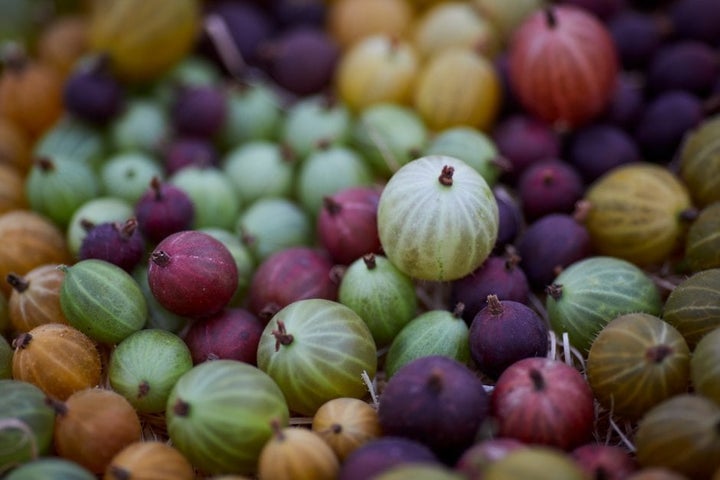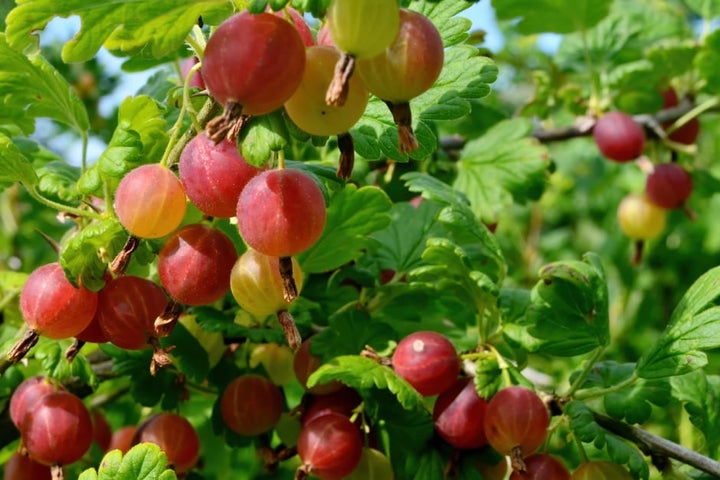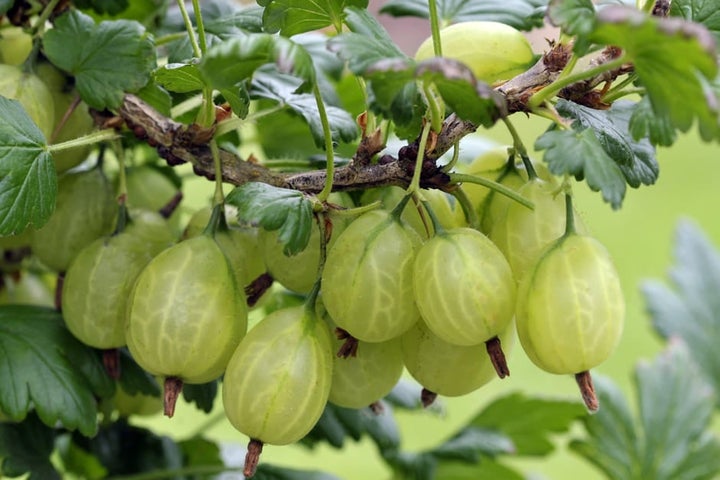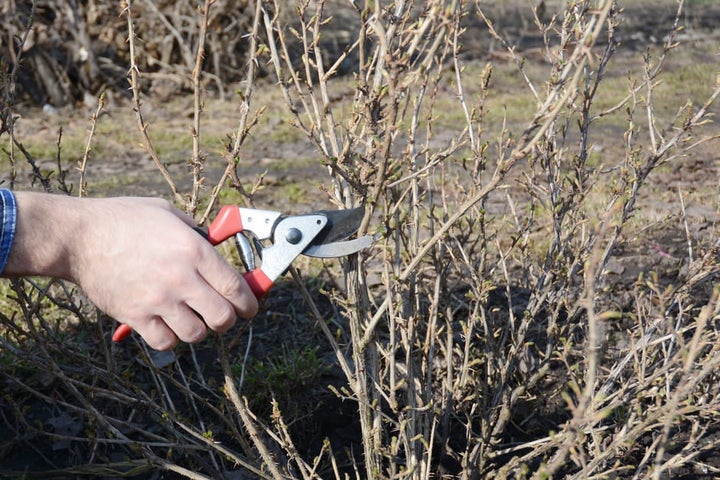Getting Started

Gooseberries (Ribes uva-crispa) are an often overlooked yet delicious fruit, rarely sold in supermarkets, so well worth growing. Once established, plants usually crop abundantly every summer for at least 10–15 years. Dessert varieties produce deliciously sweet tangy berries, while culinary varieties are great for making into pies, fools, jams and sauces.
Robust, hardy and happy in sun or light shade, gooseberries are easy to look after, both in the ground and in containers. These versatile plants can be grown as bushes, 1–1.5m (3½–5ft) tall and wide, or trained into space-saving and attractive shapes. These include narrow single-stemmed cordons and wide fans spread flat against a wall or fence. Tall slender cordons, in particular, take up little ground space and can be planted closer together, allowing you to grow several different varieties in a small area. They can also be grown as standards – shaped like a lollipop, with a bushy head on a tall stem. These are usually bought ready-trained, using grafted or budded plants that have a clear ‘trunk’ about 1m (3¼ft) tall. This attractive form makes good use of space, as you can grow other plants beneath them.
Most gooseberries should be pruned twice a year to keep them in good shape and maximise harvests, but this is a straightforward process and they need little other maintenance.
Jobs to do now
Plant new bushes
Take cuttings
Month by Month
Plant
Harvest
Choosing What To Grow

There is a wide choice of gooseberry varieties, with attractive red, green or yellow fruits that ripen from late June to early August, depending on the variety. Dessert varieties are sweet and delicious eaten raw, while culinary varieties are perfect for puddings, pies and jams. Some varieties are dual purpose.
Plant size and vigour can vary slightly depending on the variety, ranging from 1m (3¼ft) up to 1.5m (5ft) tall and wide. Most varieties have prickly stems, although a few are (almost) thornless, which makes pruning and harvesting easier. Some varieties are less susceptible to mildew, and most are happy in sun or light shade.
When choosing varieties, look for those with an RHS Award of Garden Merit (AGM), which shows they performed well in trials. If you visit any of the RHS gardens, you’ll find a wide range of fruit, including gooseberries, grown in various ways, so you can easily compare different varieties and pick up useful growing tips.
What and where to buy
Gooseberries can be bought as or container-grown plants. Bare-root plants are only available while , from late autumn to early spring, usually by mail order from fruit nurseries. Potted plants are available for most of the year and are widely sold in garden centres as well as by online retailers. Bare-root plants are usually slightly cheaper than potted ones.
For growing as a bush, choose a two- to three-year-old plant with a well-balanced head of three to five main branches and a clear stem of 10–15cm (4–6in). For a , choose either a plant with one vigorous stem, a rooted cutting or a partly trained cordon. For growing as a standard, it is easiest to buy a plant that has already been grafted and trained, as these take a long time to grow and train from scratch.
Recommended Varieties

'Greenfinch' AGM
Culinary variety Highly productive, with green fruits. Mildew resistant, fairly compact and not too spiny.

'Invicta' AGM
Culinary variety Heavy crops of well-flavoured berries. Vigorous, with some resistance to mildew.

'Leveller' AGM
Dessert variety Large yellow berries with exceptional flavour. An ideal exhibition variety.
Planting
Gooseberries are robust and hardy plants that can be grown in a wide range of locations. They cope in most soil conditions, but prefer moist, well-drained ground. They can also be planted in large containers.
They crop best and produce sweeter fruits in a sunny position, but will tolerate some shade. They can, for example, be grown in the dappled shade under fruit trees or trained against a north-facing wall. Choose a sheltered site, as the stems are brittle and can snap in windy conditions, especially when laden with fruit. Avoid sites prone to late frosts, as these can damage the flowers and so reduce fruiting. Consider planting in a fruit cage, to protect the and fruit from birds.

You can plant gooseberries from late autumn to early spring, and container-grown plants at any time – although avoid planting when the ground is , parched or frozen. Late autumn is ideal, as it gives plants plenty of time to settle in before the new starts in spring.
Take care to position the plant at the same depth it was previously growing – so with container-grown plants align the top of the level with the soil surface, and with bare-root plants align the soil mark on the stem. Allow the following spacings between plants: bushes and standards 1.2–1.5m (4–5ft) apart, cordons 30–38cm (12–15in) apart, fans: 1–1.5m (3¼–5ft) apart.
Planting gooseberries is very straightforward – see our guides below:
Planting in a container
If planting your gooseberry in a pot, choose one that’s at least 40cm (16in) wide and deep, with plenty of drainage holes in the base. Fill with a good quality, such as peat-free John Innes No.3.
Supporting plants
All trained gooseberries, apart from bush plants, need supports. Insert a sturdy bamboo at planting time to keep the main stem stable – up to 1.7m (5½ft) tall for cordons and up to 1m (3¼ft) tall for standards. Fans and cordons also need a system of horizontal wires – usually two, at 60cm (2ft) and 1.2m (4ft) from the ground, attached to posts or to a wall or fence.
Plant Care
Newly-planted gooseberries and those grown in containers need some regular maintenance to ensure they establish and grow well. Once established, plants in the ground generally need little attention, apart from pruning to keep them neat and productive and an annual in spring.
Watering
Water newly-planted gooseberries regularly during dry spells for the first couple of years after planting. After that, watering is seldom required for plants growing in the ground.
Gooseberries in pots need a steady supply of moisture throughout the growing season, so check the regularly and water as needed aiming to keep the compost evenly moist. Aim to water early in the morning or in the evening, to limit moisture loss from the soil by evaporation, ideally using stored rainwater.
As plants grow and fill their pots, check that excess water can drain freely from the holes in the bottom, as compost can cause roots to rot.

Mulching
gooseberries growing in the ground each spring, spreading a thick layer of organic matter, such as garden compost or well-rotted manure, on the soil around the base of the bushes. This helps to enrich the soil, reduce moisture loss and deter weeds. Just make sure to leave a small mulch-free circle immediately around the base of the stems to avoid rotting.
Feeding
Gooseberries growing in regularly mulched soil shouldn't need any additional feeding. However, if your soil is poor or your plant is showing signs of nutrient deficiency, apply a granular fertiliser in early spring. Use our page on nutrient deficiencies to work out what is lacking and apply the recommended feed, following instructions on the packet.
Gooseberries growing in pots benefit from regular feeding to stay healthy and productive. Either apply an organic high potassium liquid fertiliser fortnightly through the or add a handful of a granular high potassium fertiliser to the during topdressing in spring (see below).
Avoid feeding plants with too much nitrogen, as this can encourage sappy growth, which is prone to mildew.
Repotting
Container-grown gooseberries need repotting every few years into a larger container of peat-free – this is best done in spring. Once it becomes impractical to move the bush to a larger pot, repot into the same one, removing and replacing any loose compost and lightly trimming the roots.
In the years between repotting, topdress by removing the top layer of compost and replacing with fresh.
Propagating
You can make new gooseberry plants by taking hardwood cuttings from stems removed during winter pruning. should be around 30cm (1ft) long and can be rooted into pots of cuttings compost or inserted directly into a trench outdoors. Cuttings should root readily and produce several new shoots come spring.
Take care to only propagate from young, healthy plants as older ones may carry diseases that can be transferred to the resulting new plants.
Pruning And Training

To ensure good crops and to keep plants healthy and in good shape, prune gooseberries twice a year, in summer and winter.
Gooseberries can be trained into various forms, including bushes, cordons, standards and fans, each needing a slightly different pruning technique. For full details, see our guide below:
Harvesting

With gooseberries, it’s best to make two pickings, a month or two apart:
- In June, when the fruits are still green and under-ripe, pick every other fruit and use for making jam, pies, tarts and sauces. The remaining fruits should then grow larger than if you allow them all to ripen fully
- In July and August, harvest the rest of the fruits once they are ripe, for maximum flavour and sweetness. Pick fully ripened gooseberries carefully as they’re soft and burst easily
An established bush should produce 2.5–5.5kg (6–12lb) of fruit per year, and a about 1kg (2lb).
Problem Solving
It’s a good idea to grow gooseberries in a fruit cage if possible, or cover them with plastic-free or reused netting for short spells, both in winter to prevent bullfinches damaging the and in summer to protect the ripening berries from birds. Several insects and fungal diseases can also affect gooseberries (see Common Problems, below), so check plants regularly. Some gooseberry varieties offer resistance to mildew.
If frost is forecast while plants are flowering, cover with overnight, then remove during the day to allow pollinating insects to access the flowers.
Common Problems

Currant and gooseberry leaf spot
This is a fungal disease that attacks the foliage of currants (black, red and white) and gooseberries in summer, and can be troublesome in some season...

Brown scale
Brown scale is a sap-sucking insect, evidence of which can be found on woody plants at any time of year, partly because dead scales remain attached to...

Capsid bugs
Some capsid bugs can affect plants by giving the foliage a tattered and distorted appearance and causing flower buds to abort. Apple capsid can cause...










